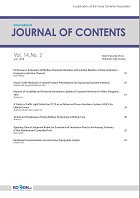- Log In/Sign Up
- P-ISSN1738-6764
- E-ISSN2093-7504
- KCI
 ISSN : 1738-6764
ISSN : 1738-6764
A Case Study: Design and Develop e-Learning Content for Korean Local Government Officials in the Pandemic
Park Sehyeon (Busan Metropolitan City Government’s HRD Institute)
JaeYoul Ryu (Busan Metropolitan City Government’s HRD Institute)
Abstract
e-Learning content can be defined as digital content to achieve educational goals. Since it is an educational material that can be distributed in offline, online, and mobile environments, it is important to create content that meets the learner's education environment and educational goals. In particular, if the learner is a public official, the vision, philosophy, and characteristics of each local government must reflect. As non-face-to-face online education expands further due to the COVID-19 pandemic, local governments that have relied on onsite education in the past urgently require developing strong basic competency education and special task competency content that reflect regional characteristics. Such e-learning content, however, hardly exists and the ability to independently develop them is also insufficient. In this circumstance, this case study describes the process of self-production of e-learning content suitable for Busan's characteristics by the Human Resource Development (HRD) Institute of Busan City, a local government. The field of instructional design and instructional technology is always evolving and growing by blending technological innovation into instructional platform design and adapting to the changes in society. Busan HRD Institute (BHI), therefore, tried to implement blended learning by developing content that reflected the recent trend of micro-learning in e-learning through a detailed analysis. For this, an e-learning content developer with certain requirements was selected and contracted, and the process of developing content through a collaboration between the client and developer was described in this study according to the ADDIE model of Instructional Systems Development (ISD).
- keywords
- ADDIE Model, e-Learning Content, Human Resource Development (HRD), Instructional System Development (ISD)
- Downloaded
- Viewed
- 0KCI Citations
- 0WOS Citations

